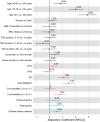Metabolic risk factor targets in relation to clinical characteristics and comorbidities among individuals with type 2 diabetes treated in primary care - The countrywide cross-sectional AUSTRO-PROFIT study
- PMID: 39359208
- PMCID: PMC11618246
- DOI: 10.1111/dom.15988
Metabolic risk factor targets in relation to clinical characteristics and comorbidities among individuals with type 2 diabetes treated in primary care - The countrywide cross-sectional AUSTRO-PROFIT study
Abstract
Aims: This study assessed the achievement rates of metabolic risk factor targets and their association with clinical characteristics and comorbidities among individuals with type 2 diabetes (T2D) treated in the primary care in Austria.
Materials and methods: A countrywide cross-sectional study, the AUSTRO-PROFIT, was conducted in Austria from 2021 to 2023 on 635 individuals with T2D. Metabolic risk factor targets were defined as the percentage of people achieving low-density lipoprotein cholesterol (LDL-C) <70 mg/dL (or < 55 mg/dL if cardiovascular or microvascular disease was present), glycated haemoglobin (HbA1c) <7% (53 mmol/mol) and blood pressure < 140/90 mmHg.
Results: The mean age of the participants was 65.7 ± 11.2 years; the median duration of T2D was 8 (4-14) years; and 58.7% of the participants were male. The percentages of participants achieving LDL-C, HbA1c, blood pressure and all targets were 44%, 53%, 57% and 13%, respectively. Older age, longer T2D duration, cardiovascular disease and microvascular complications were associated with suboptimal achievement of metabolic risk factor targets.
Conclusions: The AUSTRO-PROFIT study revealed notable variations in metabolic targets achievement with respect to clinical characteristics and comorbidities. These findings underscore the importance of establishing national diabetes registries and implementing multifactorial targeted and individualized interventions to further improve the quality of T2D care in primary care settings in Austria.
Keywords: clinical characteristics; comorbidities; metabolic risk factor targets; primary care; type 2 diabetes; type 2 diabetes care.
© 2024 The Author(s). Diabetes, Obesity and Metabolism published by John Wiley & Sons Ltd.
Conflict of interest statement
Julia K. Mader is a member in the advisory boards of Abbott Diabetes Care, Becton‐Dickinson/Embecta, Biomea, Eli Lilly, Medtronic, Novo Nordisk, Pharmasens, Roche Diabetes Care, Sanofi and Viatris; received speaker honoraria from Abbott Diabetes Care, A. Menarini Diagnostics, Becton‐Dickinson/Embecta, Eli Lilly, MedTrust, Novo Nordisk, Roche Diabetes Care, Sanofi and Ypsomed; and is a shareholder of decide Clinical Software GmbH and elyte Diagnostics. All other authors declare no conflict of interest related to this study.
Figures


References
-
- WHO . Diabetes. Accessed February 1, 2024. https://www.who.int/news-room/fact-sheets/detail/diabetes
-
- Austrian Diabetes Association . FACE DIABETES—Facts and Figures About Diabetes Mellitus . 2019. https://www.facediabetes.at/zahlen-und-fakten.html
MeSH terms
Substances
Grants and funding
LinkOut - more resources
Full Text Sources
Medical

